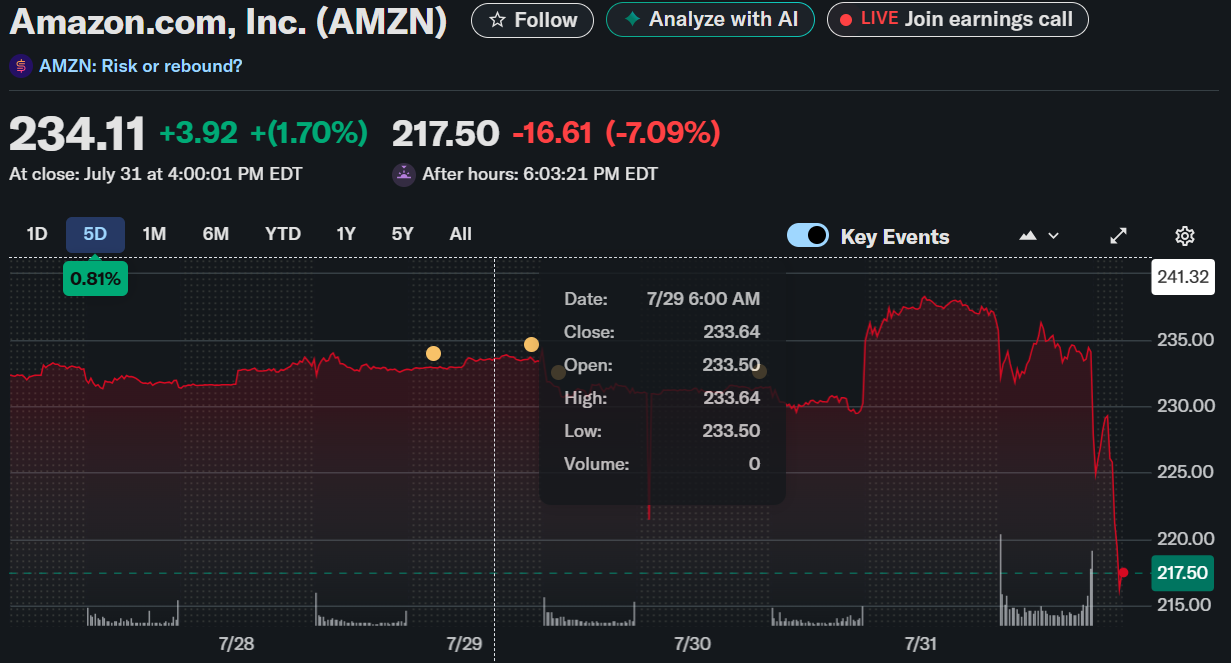TLDR
- Amazon Q2 revenue jumps 13%, but free cash flow plunge spooks investors
- AI drives Amazon’s growth, yet cash flow woes hit stock after hours
- Strong sales, bold AI moves—but Amazon’s cash burn rattles the market
- Amazon soars on earnings, dives after hours on free cash flow concerns
- AWS shines, AI surges, but shrinking cash dims Amazon’s Q2 celebration
Amazon’s stock (AMZN) closed at $234.11 on July 31, up 1.70% during regular trading hours, but sharply dropped to $222.00 in after-hours trading, losing 5.17%

Robust Revenue Growth Across All Segments
Amazon reported net sales of $167.7 billion for Q2 2025, marking a 13% increase from the previous year. North America contributed $100.1 billion, while the international segment generated $36.8 billion, both showing solid year-over-year growth. The AWS division led with $30.9 billion in revenue, up 17.5% from Q2 2024.
Amazon, $AMZN, Q2-25. Results:
📊 EPS: $1.68 🟢
💰 Revenue: $167.7B 🟢
📈 Net Income: $18.2B
🔎 AWS led the way with $30.9B in sales, and Amazon delivered record Prime Day results amid major AI-driven product rollouts. pic.twitter.com/U1P5uOgqpy— EarningsTime (@Earnings_Time) July 31, 2025
Segment operating income followed a similar upward trend, with AWS earning $10.2 billion, North America $7.5 billion, and International $1.5 billion. Overall operating income rose to $19.2 billion, compared with $14.7 billion a year earlier. Net income climbed to $18.2 billion, or $1.68 per diluted share, up from $13.5 billion.
Amazon’s guidance for Q3 2025 predicts net sales between $174.0 billion and $179.5 billion, reflecting continued momentum. Operating income is projected to range from $15.5 billion to $20.5 billion. The company anticipates some benefit from foreign exchange rates, boosting its outlook slightly.
AI-Fueled Expansion Spurs Innovation and Efficiency
Amazon highlighted aggressive growth in AI-powered services across its retail, cloud and logistics operations during the quarter. It launched DeepFleet to optimize the paths of over one million warehouse robots, increasing travel efficiency by 10%. AI improved demand forecasting, enhancing inventory accuracy by 20%.
The company introduced Nova Act, a new tool for building action-driven agents, alongside expanded language support for its Sonic voice AI. It also released Bedrock AgentCore and Kiro IDE to simplify the development and deployment of secure, scalable agents. These tools aim to make AI capabilities more accessible across industries.
Partnerships continued to expand, with new AWS agreements from global enterprises like SAP, PepsiCo, Airbnb and Nissan. Amazon opened “AI Zones” in Saudi Arabia and Korea, and made AI tools available in AWS Marketplace. Infrastructure investment also grew, with multibillion-dollar projects announced in North Carolina, Pennsylvania, and Australia.
Free Cash Flow Decline Raises Red Flags
Free cash flow dropped significantly to $18.2 billion over the last twelve months, down from $53.0 billion. This unexpected decline raised market concerns and overshadowed operational gains. It signaled heavier capital spending amid increased AI investment and cloud expansion.
Operating cash flow did rise 12% to $121.1 billion, but it was not enough to offset the sharp fall in free cash. The company attributed part of the pressure to high infrastructure outlays and growth-related expenses. Nevertheless, management remained confident in long-term returns from these initiatives. While AI-driven growth remains strong, financial discipline will be essential moving forward.






